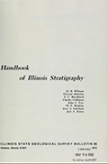Historical:Grassy Creek Shale: Difference between revisions
mNo edit summary |
(No difference)
|
Latest revision as of 20:48, 5 January 2017
Lithostratigraphy: Knobs Megagroup >>New Albany Shale Group >>Grassy Creek Shale
Chronostratigraphy: Paleozoic Erathem >>Devonian System >>Upper Devonian Series
Allostratigraphy: Kaskaskia Sequence
Authors
Charles Collinson and Elwood Atherton
Name Origin
The Grassy Creek Shale (Keyes, 1898, p. 59-63; 1912, p. 149; Collinson et al., 1967a, p. 961) is named for Grassy Creek, a stream in Pike County, Missouri.
Type Section
No type section was designated for the Grassy Creek Shale and some of the sections referred to by Keyes include Maquoketa Shale (Weller, 1936). Mehl (1960) named a section in the Mississippi bluffs several hundred feet north of the Champ Clark Bridge at Louisiana, Pike County, Missouri, as the type locality (SW NW NE 18, 54N-1W).
Extent and Thickness
In Illinois the Grassy Creek was at first restricted to the western part of the state, but in 1956 Workman and Gillette extended it to central and southwestern Illinois in place of the Mountain Glen Shale, a name long used in that area (Savage, 1920; Weller, 1940). Still later it was extended to eastern Illinois (Collinson et al., 1967a; North, 1969). The Grassy Creek occurs in nearly all the area in which Upper Devonian strata appear. It is well exposed in Pike, Calhoun, and Jersey Counties in western Illinois and in Union County and locally in Hardin County in southern Illinois (fig. D-18).
Definition
The Grassy Creek Shale originally included all the black, gray, and green shale below the Louisiana Limestone and above the Cedar Valley or older formations, but in 1912 Keyes differentiated the upper gray shale as the Saverton Shale, and Collinson et al. (1967a) restricted the Grassy Creek further by assigning the lower gray and green shale to the Sweetland Creek Shale.
Stratigraphic Position
In subsurface its high resistivity on electric logs serves to differentiate it from the Saverton Shale above and from the Sweetland Creek Shale below.
References
COLLINSON, CHARLES, L. E. BECKER, G. W. JAMES, J. W. KOENIG, and D. H. SWANN, 1967a, Illinois Basin, in International symposium on the Devonian System: Alberta Society of Petroleum Geologists, v. 1, p. 940-962; Illinois State Geological Survey Reprint 1968-G.
KEYES, C. R., 1898, Some geological formations of the Capau-Gres uplift: Iowa Academy of Science Proceedings, v. 5, p. 58-63.
KEYES, C. R., 1912, Some provincial and local phases of the general geologic section of Iowa: Iowa Academy of Science Proceedings, v. 19, p. 147-151.
MEHL, M. G., 1960, Relationships of the base of the Mississippian System in Missouri: Denison University Journal of Scientific Laboratories, v. 45, p. 57-107.
NORTH, W. G., 1969, Middle Devonian strata of southern Illinois: Illinois State Geological Survey Circular 441, 45 p.
SAVAGE, T. E., 1920, Devonian formations of Illinois: American Journal of Science, v. 49, p. 169-182.
WELLER, J. M., 1936, Grassy Creek shales: Illinois Academy of Science Transactions (1935), v. 28, p. 191-192.
WELLER, J. M., 1940, Geology and oil possibilities of extreme southern Illinois: Illinois State Geological Survey Report of Investigations 71, 71 p.
WORKMAN, L. E., and TRACEY GILLETTE, 1956, Subsurface stratigraphy of the Kinderhook Series in Illinois: Illinois State Geological Survey Report of Investigations 189, 46 p.
ISGS Codes
| Stratigraphic Code | Geo Unit Designation |
|---|---|

